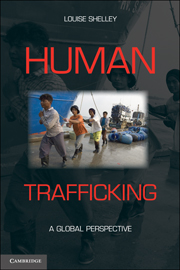Book contents
- Frontmatter
- Contents
- Acknowledgments
- Introduction
- Part I The Rise and Costs of Human Trafficking
- Part II The Financial Side of Human Trafficking
- Part III Regional Perspectives
- 5 Asian Trafficking
- 6 Human Trafficking in Eurasia and Eastern Europe
- 7 Trafficking in Europe
- 8 Trafficking in the United States
- 9 Human Trafficking in Latin America and Africa
- Conclusion
- Index
- References
6 - Human Trafficking in Eurasia and Eastern Europe
Published online by Cambridge University Press: 05 June 2012
- Frontmatter
- Contents
- Acknowledgments
- Introduction
- Part I The Rise and Costs of Human Trafficking
- Part II The Financial Side of Human Trafficking
- Part III Regional Perspectives
- 5 Asian Trafficking
- 6 Human Trafficking in Eurasia and Eastern Europe
- 7 Trafficking in Europe
- 8 Trafficking in the United States
- 9 Human Trafficking in Latin America and Africa
- Conclusion
- Index
- References
Summary
The collapse of the Soviet Union has been identified in this book as one of the major events explaining the recent rise in human trafficking. The end of the Cold War had its greatest impact in the former Soviet Union and the former socialist bloc of Eastern Europe. Human trafficking proliferated in the final years of the Soviet period, in the 1980s. At first, trafficking victims were primarily women, but after the dissolution of the USSR, diverse forms of trafficking developed, facilitated by the rise of organized crime, the decline of borders, high levels of corruption, and the incapacity of the transitional states to protect their citizens. Also contributing to human susceptibility to traffickers were the social and economic collapse, discrimination against women and minorities, and the conflicts that accompanied the demise of the socialist system. Millions were unemployed, disoriented, displaced, and vulnerable to exploitation. This chapter focuses on trafficking in the Soviet successor states and the countries of Eastern Europe that are not part of the European Union (EU).
This region, which spans Europe and Asia, is characterized by enormous cultural, political, economic, and religious diversity. Parts of the former Soviet Union such as the Baltic States have standards of living approximately 40 percent of the level of long-time members of the EU, whereas income levels in the impoverished countries of Central Asia and Moldova in the worst periods averaged as little as $50 monthly. These economic differences are accompanied by equally significant political differences. As EU members, the Baltic States are becoming stable democracies, whereas other regions, particularly Belarus and Central Asia, are even more authoritarian than in the final years of the Soviet period. Although all lived in the atheist USSR, religion has resurged in the post-Soviet period among both Christians and Moslems.
- Type
- Chapter
- Information
- Human TraffickingA Global Perspective, pp. 174 - 200Publisher: Cambridge University PressPrint publication year: 2010



